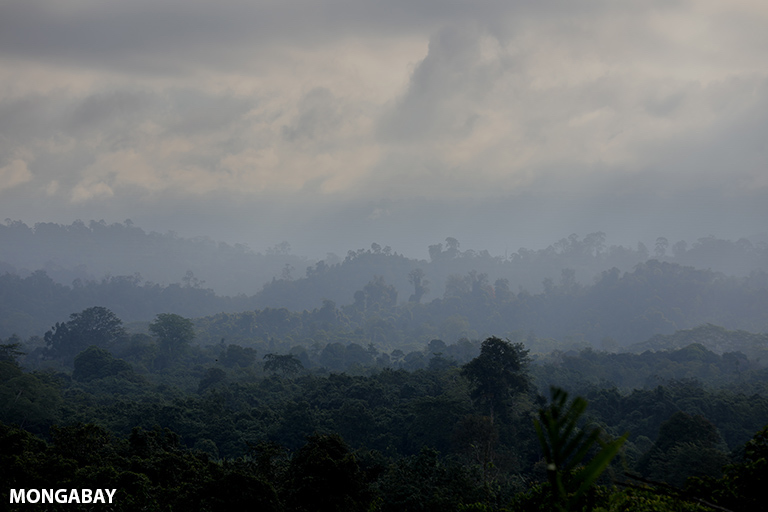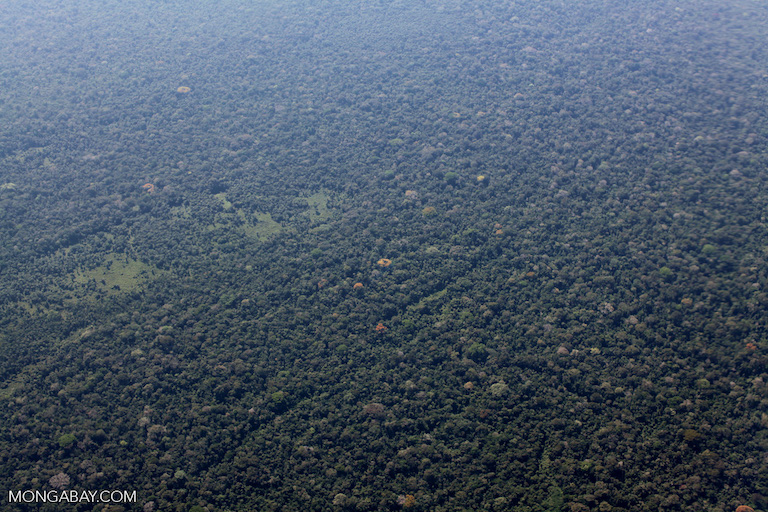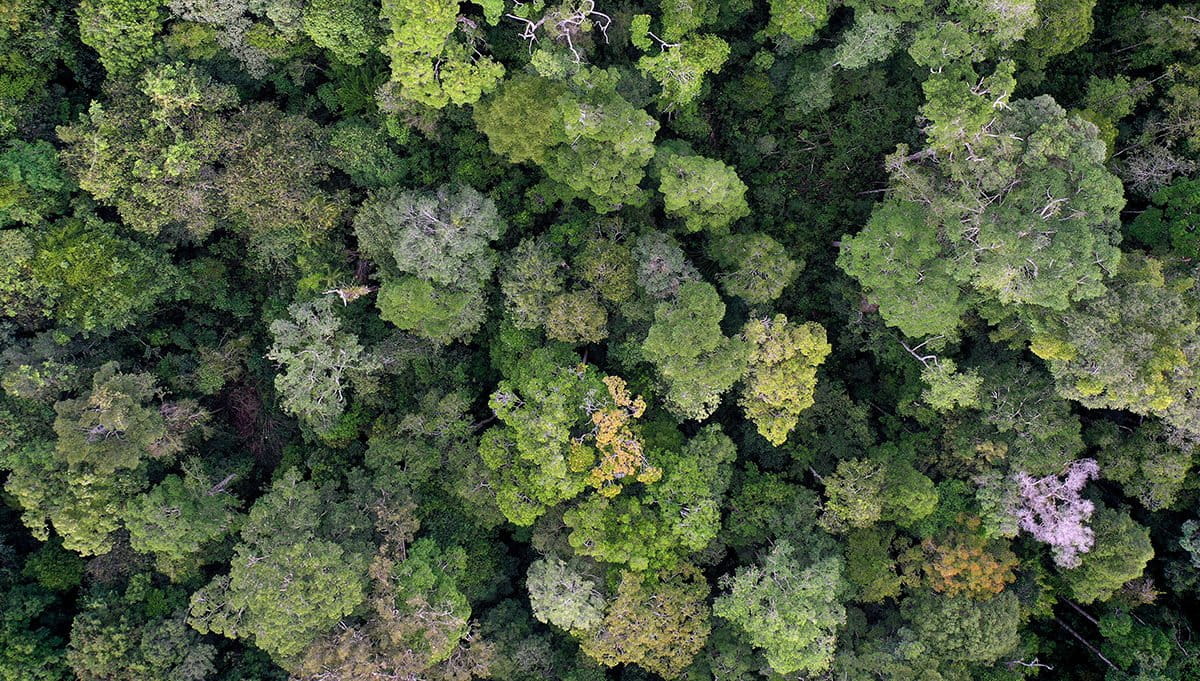- A new study evaluated soundscape saturation in a tropical forest in East Kalimantan, Indonesia, before, during and after selective logging activities.
- It found that animal sounds promptly dropped after selective logging, but that the soundscape would recover after about a year. But two or three years after logging, soundscape saturation diminished again.
- Insects appeared to be less affected by selective logging than birds, the study found.
- Another expert not involved in the study says more realistic findings would have been obtained by recording the sounds from random locations in the forest instead of at the specific logging sites.
A recorder is fastened to a tree, its microphone pointed downward. It captures a fusion of sound: the high-pitched buzz of cicadas, bird calls, and also the rumbling of a chainsaw cutting through wood somewhere below.
Between 2016 and 2017, a team of international scientists set up recorders in a tropical forest in East Kalimantan province, in Indonesian Borneo, to figure out what the forest sounded like before, during and after selective logging. More specifically, they were calculating “soundscape saturation,” which is the measurement of animal sound frequencies that correlates with the number of species present in the area.
A recording of the forest in East Kalimantan, Indonesia, during logging. Audio courtesy of Zuzana Burivalova.
The researchers found that the number of animal sounds “dropped immediately” after selective logging in the immediate area.
“In a way, this is not surprising — for any animal, living in an area where selective logging happens must wreak a lot of chaos and destruction,” Zuzana Burivalova, a tropical forest ecologist at the University of Wisconsin-Madison and lead author of a new paper on the subject, told Mongabay.
“It is a very unique experience to be able to listen to the forest the day after logging stops,” she added. “Everything seems very quiet, like after a big storm passes by.”

Logging appeared to have a particularly negative impact on birds. But insects, on the other hand, seemed to thrive. This could be due to the disappearance of insect-eating birds, a lack of acoustic competition, or the creation of a “more favourable microclimate due to logging gaps,” according to the researchers. In the long term, selective logging could even produce new food sources for insects, the paper suggests.
“I think that insects may be less dependent on a particular species of tree, or a particular feature in the habitat, for survival, compared to birds,” Burivalova said. “It also seems, from my studies but also from other studies done in Peru, that insects that make sound might be actually thriving in parts of the forest that are recently disturbed by logging. For insects that eat plant leaves, a new gap in the canopy could quickly become a promising pasture — young plants, able to grow quickly because of the extra sunlight reaching them through the gap in the otherwise dark forest, might be more tasty than old trees.”
A year after selective logging, the soundscape saturation seemed to somewhat “recover,” according to the study. But strangely enough, it dropped again two or three years afterward. The researchers are still trying to figure out why.
“[A]n initial disturbance from the logging could attract species that like gaps in the canopy,” Burivalova said. “But, after 2-3 years, the canopy may be already closed, so those initial disturbance loving species might move on, whereas the species that need mature, old forest might not yet be back. But at this point, this is only a speculation.”

This research project is only considered to be a pilot study, said Burivalova, adding that it will be important to follow the recovery of these forests for several more years. But the results of the study can already assist conservation efforts, she said.
“Several things are already well known — don’t log at too high an intensity, don’t allow illegal logging and hunting, and wait the prescribed number of years to re-enter a certain area to extract more trees,” she said.
Jack Putz, a distinguished professor of biology and forestry at the University of Florida, who was not involved in the study, said the acoustical techniques used in the study have great potential for efficient monitoring of logging concessions in tropical forests.
“To improve tropical forestry we need to know what is going right and what is going wrong,” he told Mongabay. “The ecoacoustics technique for which this paper serves as a proof-of-concept, represents a promising way to monitor the biodiversity impacts of logging and other silvicultural interventions. The techniques apparently are still under refinement, and it would help to know how much each recording station costs, but we do know that stationing human biodiversity monitors in the field for long periods of time is prohibitively expensive.”

But Putz said recording in close proximity to the logging, rather than planting the recorders at non-specific sites, creates “a very biased picture of the consequences of logging at meaningful scales.”
“This is a long standing bias in the study’s impact analyses of logging,” he said. “[T]hey go right to where the trees are felled or right to where the skid trails are, rather than sampling at random, which is what the correct scientific protocol would be, if what you’re interested in is the effect at the landscape level.”
Citations:
Burivalova, Z., Purnomo, Orndorff, S., Truskinger, A., Roe, P., & Game, E. T. (2021). The sound of logging: Tropical forest soundscape before, during, and after selective timber extraction. Biological Conservation, 254, 108812. doi:10.1016/j.biocon.2020.108812
Campos-Cerqueira, M., Mena, J. L., Tejeda-Gómez, V., Aguilar-Amuchastegui, N., Gutierrez, N., & Aide, T. M. (2019). How does FSC forest certification affect the acoustically active fauna in Madre de Dios, Peru? Remote Sensing in Ecology and Conservation, 6(3), 274-285. doi:10.1002/rse2.120
Banner image caption: Kalimantan forest. Image by Rhett A. Butler for Mongabay.
Elizabeth Claire Alberts is a staff writer for Mongabay. Follow her on Twitter @ECAlberts.
FEEDBACK: Use this form to send a message to the author of this post. If you want to post a public comment, you can do that at the bottom of the page.
